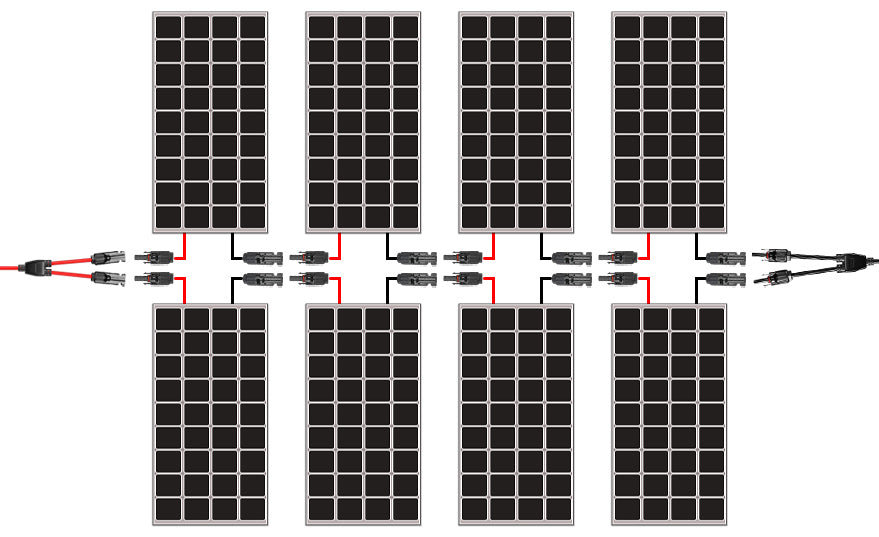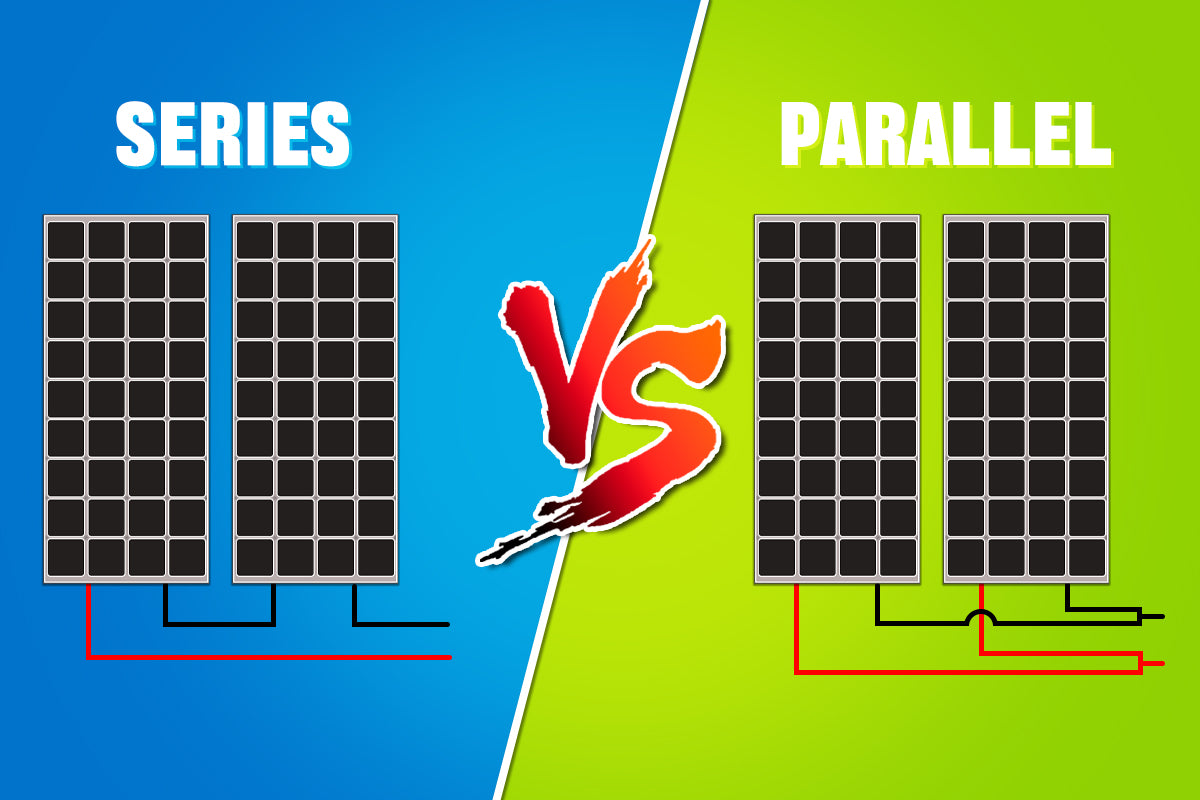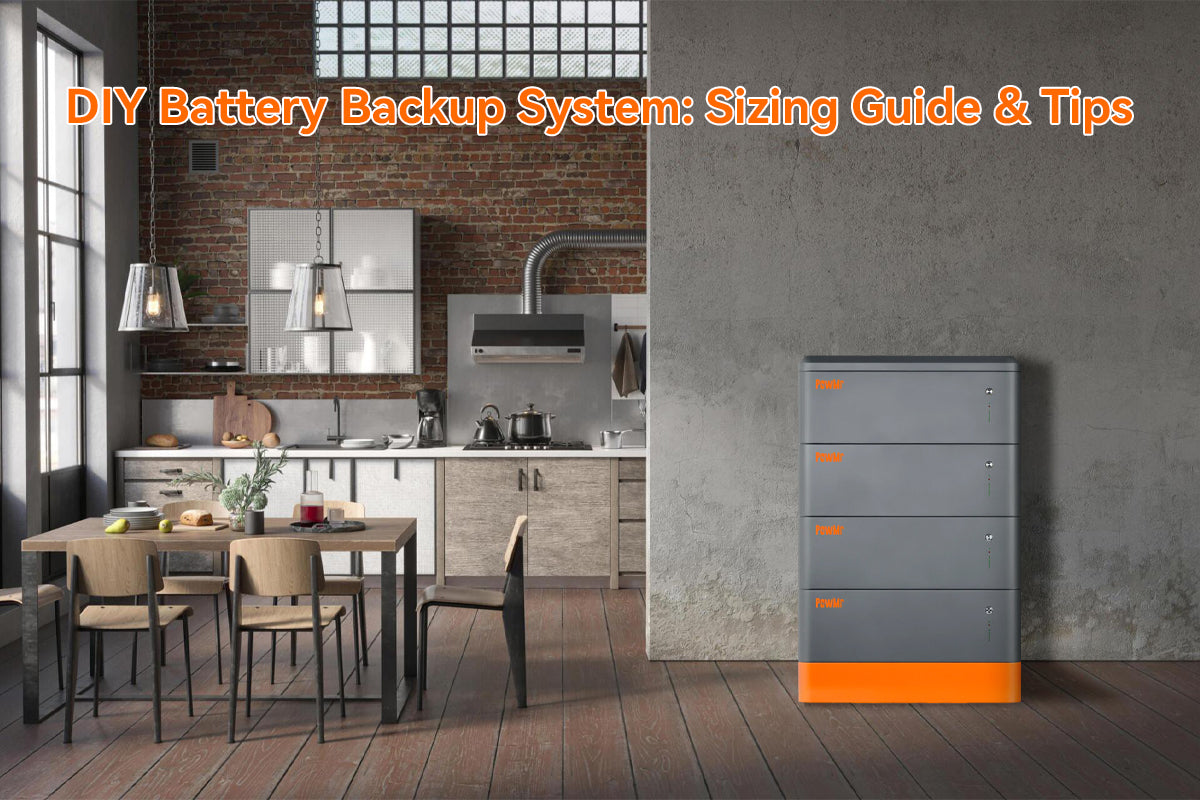Understanding how to connect solar panels optimally can be a maze, especially for beginners. With myriad options and considerations, the process of linking solar panels together to harness the sun's energy efficiently can seem daunting.
In this comprehensive guide, we'll navigate through the maze, shedding light on how are solar panels connected and which wiring method is better for your solar system. Whether you're starting your first solar project or seeking to improve an existing system, this guide will offer clarity and valuable insights tailored to your needs.
- How are solar panels connected together?
- Why connect solar panel in series?
- How to wire solar panel in series?
- Why connect solar panel in parallel?
- How to wire solar panel in parallel?
- Solar Panels Series vs Parallel - Pros and Cons
- Wire solar panels in series or parallel - which is better
- Can you wire solar panel in series and parallel?
- FAQs on series or parallel connection of solar panels
How are solar panels connected together?
The solar panels are typically connected via two methods: series or parallel. The choice depends on several factors including energy demand, type of solar charge controller, solar inverter, battery system, and environmental conditions.
Solar panels typically require a junction box, which is usually installed on the back of rigid panels or on the top front of flexible solar panels. The installation position may vary depending on the model, with some panels equipped with a junction box. This box comprises components such as a cover, housing, terminal blocks, diodes, and positive/negative connectors. Connections between solar panels are established using these connectors and appropriately sized PV cables. And various connection methods may require additional tools, also covered in in the relevant wiring steps. Furthermore, extension wiring necessitates the use of MC4 solar connectors and extension cables, as illustrated in the diagram below.

Why connect solar panel in series?
Connecting solar panels in series results in an increase in voltage while maintaining the same amperage as a single panel.
Assuming you have two 100 Watt flexible solar panels? (each with an open circuit voltage of 21.6 volts and 6.1 amps) and a 24V battery bank to charge, you need to connect them in series to increase the voltage. Multiplying the open circuit voltage of one panel (21.6 volts) by the number of panels (2) gives us the total voltage output. So, it would be 21.6 volts x 2 = 43.2 volts. The amperage remains at 6.1 amps. We use the open circuit voltage for safety, ensuring it's within? the maximum input voltage of the charge controller.
Wiring solar panels in series is common in scenarios where:
- Solar batteries necessitate higher voltage. It's imperative to ascertain whether your battery system operates at low voltage or high voltage.
- Energy needs to be distributed over long distances.
- sunlight is low, individual solar panels may not generate enough voltage to efficiently charge batteries or power electrical loads.
Note:
Due to the increased voltage in a series connection, it is crucial to consider the maximum system voltage specified in the datasheet on the back of the solar panels when determining how many solar panels can be connected in series. And ensures that the short-circuit current of the solar panels does not exceed the rated current of the solar charge controller and battery.
How to wire solar panel in series?
When wiring solar panels in series, begin by ensuring that each panel has a junction box with clearly marked positive and negative connectors. If additional extension is required, utilize MC4 connectors and extension cables.
Wiring solar panels in series is straightforward. Find the positive and negative connectors from each junctionbox of the solar panel. Insert the positive (usually red with male pins) connector of one panel to the negative (typically black with female sockets) connector of the next panel. Repeat this process for all subsequent panels until all are connected in series.

Why connect solar panel in parallel?
When connecting solar panels in parallel, the voltage remains the same as that of a single panel, while the amperage adds up across all connected panels.
For instance, if you have two 100 Watt solar panels with an open circuit voltage of 21.6 volts and 6.1 amps each, connecting them in parallel would maintain the voltage at 21.6 volts and double the amperage to 12.2 amps.
When to Connect Solar Panels in Parallel
- If your system requires higher amperage rather than voltage, connecting panels in parallel is the way to go.
- Parallel connections allow for easier expansion of the existed system, as you can simply add more panels in parallel without affecting the voltage.
How to wire solar panel in parallel?
When wiring solar panels in parallel, ensure each panel has a junction box with clearly marked positive and negative connectors. Parallel connection involves linking all positive terminals together and all negative terminals together. Additionally, for parallel connections, utilize MC4 connectors and extension cables if needed.
For parallel connections, use either branch connectors or a combiner box. Branch connectors come in Y-type and T-type configurations, with separate sections for positive and negative terminals. Each section allows multiple inputs of the same polarity to combine into a single output.
Here's a diagram illustrating the parallel connection of 3/4 solar panels using a 2-to-1 Y-type branch connector:

Finally, connect the positive cable bundles to the charge controller's positive input and the negative bundles to the negative input.
Solar Panels Series vs Parallel - Pros and Cons
Pros And Cons Of Series connection
Benefits of wiring solar panels in series
Reduced Component Bulk
Due to lower total amperage, series connections eliminate the need for bulky cables and components, streamlining the system design.
Lower Transmission Losses
Higher voltage in series connections reduces power loss during long-distance transmission, enhancing overall system efficiency.
Enhanced Performance
Series strings excel in low-light conditions at dawn and dusk, enhancing overall energy capture efficiency. Increasing the total output voltage of solar panels is beneficial for initiating the operation of MPPT solar charge controllers as early as possible.
Disadvantages of connecting solar panels in series
Performance Dependency
The performance of a series configuration is contingent upon the weakest panel, leading to reduced efficiency if one panel is shaded.
High Voltage Requirement
Series setups necessitate a high voltage-tolerant charge controller and solar inverter, adding complexity and cost to the system.
Pros And Cons Of Parallel Wiring
Benefits of wiring solar panels in parallel
Isolated Performance
Each panel operates independently in parallel wiring, ensuring that shading or malfunctions in one panel do not significantly impact others, maintaining overall system efficiency.
Increased Amperage
Parallel connections boost amperage output, ideal for systems requiring higher current demands, such as direct appliance powering or low-voltage battery charging.
Flexible Expansion
Parallel wiring allows for easy system expansion by adding more panels without affecting voltage, offering scalability to meet growing energy needs.
Reduced Electrical Risk
Lower voltage in parallel setups mitigates potential electrical risks associated with high-voltage systems.
Disadvantages of connecting solar panels in parallel
Complex Installation
Parallel connections entail managing multiple cable runs, branch connectors, or combiner boxes, potentially increasing installation complexity and cost.
Compatibility Challenges
Different solar panel (brand, size) in parallel systems may cause damage and reduce efficiency. Differing panels make stronger ones overcompensate for weaker ones, exacerbating compatibility issues and performance loss.
Increased Cable Cost
Higher amperage in parallel setups necessitates heavier, more expensive cables, adding to installation expenses.
Wire solar panels in series or parallel - which is better
The choice between series and parallel connections for solar panels depends on specific requirements and conditions.
When series connection are preferred
- Limited space but high voltage requirement, such as rooftop installations.
- Need to maximize voltage output without expanding physical area.
When parallel connections are preferred
- Shading is a concern, allowing individual panels to operate independently.
- Applications like RVs, boats, or low-voltage setups prioritize flexibility and individual panel performance.
Can you wire solar panel in series and parallel?
Moreover, you have the option to connect solar panels in both series and parallel setups to maximize voltage and current. To begin series-parallel wiring, first, organize panels into series groups, such as 2, 3, 4, etc., forming what's called a string. Then parallel all these equal strings using branch connectors.
As shown in the diagram, there are two strings, each consisting of four 12V 100W solar panels with a short circuit current of 6.1A, resulting in a voltage output of 48V. When these two strings are paralleled, the voltage remains at 48V, while the current doubles to 12.2A.

FAQs on series or parallel connection of solar panels
Can different solar panels be connected in parallel?
No, connecting different solar panels in parallel is not recommended due to varying electrical characteristics. This can lead to inefficiencies and potential damage to the panels.
Do solar panel charge faster in series or parallel?
Solar panel in series connection is faster if under low light conditions, it rapidly initiates charging as soon as light touches the panels, bypassing the gradual voltage climb needed to exceed the charging threshold.
Should 12V solar panels be wired in series or parallel?
Whether 12V solar panels should be wired in series or parallel depends on specific requirements. If you need to maintain voltage but increase current, parallel wiring is suitable. However, if you require higher voltage output, series wiring would be preferable.
Can you add more solar panels to an existing system?
Certainly, you can add more solar panels to your current system. However, it's important to ensure that their voltage, current, and power align with the specifications of your system's controller and inverter.



Leave a comment
This site is protected by reCAPTCHA and the Google Privacy Policy and Terms of Service apply.